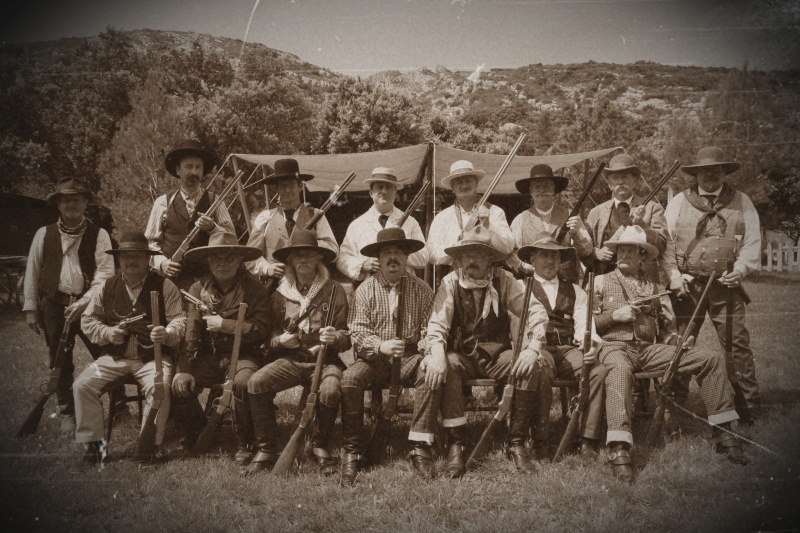
Make no mistake about this “Rawhide Ranger.” Though posed in a photographer’s studio—with weapons prominently displayed as attention-grabbing props—Texas Ranger Ira Aten was a man fearlessly capable of standing alone during a dicey tumult, proving to be one nervy adversary throughout a number of gunfights. I like this photo of Aten because he looks salty.

exas Ranger Cpl. J. Walter Durbin (at right) said he had some 15 good men in Company D, though a few could be a “little fussy and dangerous” when drinking. Private Wood Saunders (at left) measured up splendidly—on both counts. This is one of my favorite photos because it shows how both Rangers carried their six-shooter Colts just forward of the hip, butt to the front, easily permitting a strong-hand cross draw.

This photo of Company D Texas Rangers is one of a series of five photographs that play out a story for a photographer. The camp scene shot stands out because it has several of the most prominent Texas Rangers: Sergeant Ira Aten (standing with cup) issues the marching orders; (seated, from left) Jim King, Frank L. Schmid, Ernest Rogers, Cal Aten, Walter Jones, Charley Fusselman, J. Walter Durbin, Jim Robinson, John R. Hughes and Bass (Baz) Outlaw.

This photo shows the transition to more advancing technology; these Winchester warriors wear cartridge belts stuffed with modern-era smokeless powder rifle cartridges. (Standing, from left) Herff Alexander Carnes, Sam McKenzie and Arthur Beech. (Seated, from left) Tom Ross, Albert Mace and John R. Hughes.
Courtesy Texas Ranger Research Center, Texas Ranger Hall of Fame & Museum

I love this image of James B. “Jim” Hawkins, a charter member of Company D of the Texas Rangers, because he definitely looks like he’s loaded for bear.
Courtesy Chuck Parsons

his Frontier Battalion photo has been widely circulated; you’ll see it on postcards, t-shirts, even walls of restaurants. I like this classic photo because it was taken either before or after the famous 1892 shoot-out in Shafter, Texas, where the Texas Rangers had been sent to protect a silver mine. (Standing, from left) Robert “Bob” Speaks and Jim Putman. (Seated, from left) Alonzo Van “Lon” Oden and John R. Hughes. Ira Aten had recommended Hughes to the Texas Rangers after Hughes ably assisted him in the 1886 pursuit of murderer Wes Colliers.
Courtesy Robert G. McCubbin Collection

This photo of Samuel H. “Sam” Newberry is great because it shows the Texas Ranger making the transition to professionalism, through dress. But even though he looks quite natty in this photo, folks could tell he was a dangerous man. Typically, as most lawmen would, Newberry made sure the shutterbug had the Ranger’s six-shooter Colt and fancy Mexican Loop holster and cartridge belt in the frame.
Courtesy Texas Ranger Research Center, Texas Ranger Hall of Fame & Museum

Statistically, the odds were stacked against this unsuspecting cluster of lawmen. At least five of these Company D Texas Rangers would die violently at the hands of others and, for that reason, this photo is among my top 10. (Standing, from left) Jim King, Bass Outlaw, Riley Boston, Charley Fusselman, Tink Durbin, Ernest Rogers, Charles Barton and Walter Jones. (Seated, from left) Bob Bell, Cal Aten, Captain Frank Jones, J. Walter Durbin, Jim Robinson and Frank L. Schmid.
Courtesy Texas Ranger Research Center, Texas Ranger Hall of Fame & Museum

Company D Texas Rangers
Courtesy Texas Ranger Research Center, Texas Ranger Hall of Fame & Museum
